
The electrical giant Philips of the Netherlands was for many years the dominant manufacturer of semiconductors in Europe. When Bell Labs announced the discovery of the transistor, Philips was quick to understand its potential and to establish research and manufacturing capabilities in Eindhoven in the Netherlands, but it also established research and manufacturing plants in the UK under its subsidiary Mullard Ltd., and in West Germany under the Valvo subsidiary. The three countries all produced the same transistor product lines, starting with the original OC series of germanium transistors and OA series of germanium diodes. In France, Philips had a subsidiary called La RadioTechnique that seems to have made some semiconductors, but fewer than the other countries. In the USA, Philips semiconductors were sold by Amperex Electronic Corporation, I am unsure if they really manufactured any, as many are marked 'MADE IN HOLLAND'.
Philips has a logo based on a shield as shown, but sometimes also just uses its name in capitals. However it never printed the logo, and very rarely printed the name, on its transistors or diodes (although it did on their boxes), whereas Mullard and Valvo usually did print their name. Therefore unbranded OC transistors, for instance, may have been made in the Netherlands by Philips (and are sometimes printed MADE IN HOLLAND or just HOLLAND, even when branded Mullard). Philips also used the brand 'miniwatt' on their valves/tubes and carried it over into some of their semiconductor boxes. Because it's hard to identify Philips examples, I don't show the bulk of Philips types here, but list them under Mullard or Valvo.
The history of Philips' first semiconductors is the subject of some excellent research and documentation by Mark Burgess, a fellow enthusiast. I shall therefore not repeat such information here.

However, Philips were not the only Dutch company selling transistors: they were also marketed by a company called Van der Heem, and their customer Amroh. I give more details if this below but information is scarce so if you know about Van der Heem semiconductors, please
I do not possess all the transistors below, in fact I am seeking many of them. It is noted in the text where I am seeking examples of any particular type. If you have some for sale or exchange, please
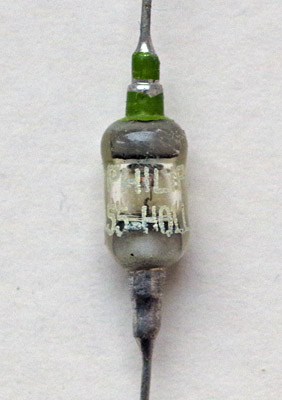
Here is an exception: the very early OA55 diode printed PHILIPS HOLLAND.
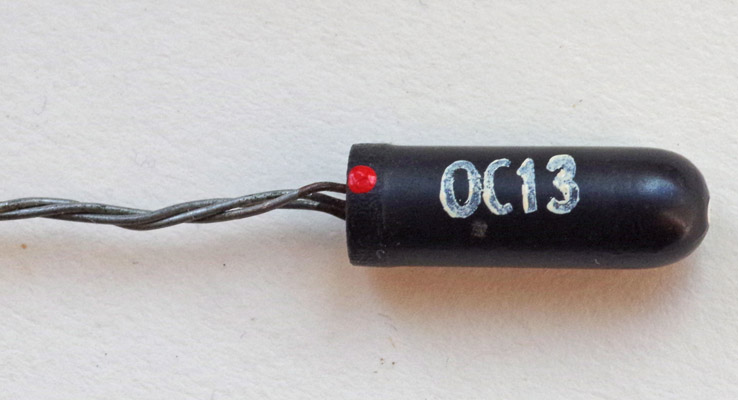
There is one oddity, mentioned on Mark's site, that is worth highlighting. Philips sold out-of-spec examples of their OC71 and OC72 transistors renumbered as OC13 and OC14, and marketed at the electronic hobbyist. As far as I know, these were never sold by Mullard or Valvo. They were included in some of Philips' early 'Pionier' electronic component kits. Both types are listed on the radiomuseum Web site. This OC13 has no markings other than the part number.
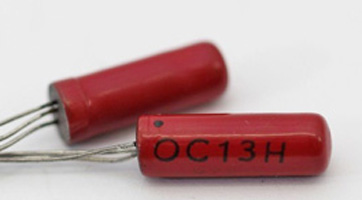
This image shows an extraordinary red-painted version of OC13 with a suffix H, possibly used for a specific application. Again there are no markings other than the part number. I'm aware that there also exists a red OC13J.
If you know what the red OC13s with suffixes were intended for, please
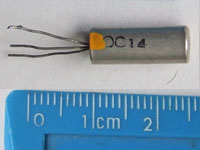
Here is an OC14 in the standard SO-2 metal that Philips used for early 'power' types, although this is more correctly considered medium power. Oddly, radiomuseum shows an OC14 in an SO2 glass capsule, which is not correct for an OC72 as the datasheet shows. This is a mystery.

Returning to Van der Heem, the company was primarily a manufacturer of radios, although they did sell transistors. Some information about this can be found on Hans Hilberink's site. The link at the bottom of that page, to Gerald Tel's page, is broken: here is the correct one.
Considerably more company information and history can be found on the site https://vanderheem.com/en/history/. This contains all sorts of material such as internal company news, annual reports, staff magazine articles and advertising material. These include a number of articles about transistor manufacture that reveal that VdH had a commercial agreement with the American semiconductor manufacturer General Transistor International Corporation. A document on the site states that General Transistor trained VdH technicians in the manufacture of transistors, and would 'assist ... in purchasing machines and materials for manufacturing transistors'. Another document states that VdH wishes to expand its production of transistors and staff may apply to work on this. These documents strongly suggest that VdH did in fact manufacture transistors themselves, something of which I was unsure. However, Hans Hilberlink states that VdH transistors were '...produced by companies as TeeKaaDee,(sic) Telefunken, RCA, Ates and others' to VdH specifications. I am inclined to doubt this, when many VdH transistors use exactly the same TO-9 outline as General Transistor devices did. If VdH bought the same manufacturing equipment as GTI used, that would explain why.
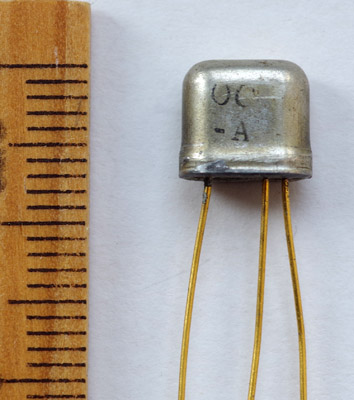
The oldest VdH data that I possess is a scan of a booklet called 'Transistors' dated 20-2-58. This describes three ranges of germanium AF transistors:
My image shows a VdH transistor in the SO4-style oval outline, just printed OC-A. It is either an early prototype or an example that should have had the number 2, 3 or 4 added later, depending on measured charcteristics. At the time it was common to sort the output of a transistor production line by, for example, gain or frequency response, and number the device accordingly.
Care should be taken if you find an apparent source of some Van der Heem OC types, because there exist vacuum tubes with part numbers OC2, OC3 and OC4.
I have a scan of a later Van der Heem transistor list dated November 1963 that a correspondent has sent me. By this time VdH were selling many more types, and like the three ranges above it is the suffix that determines the type of a device. In each type group, OC1 has the lowest gain, and OC6 the highest. So, there are several groups of high-frequency transistors:
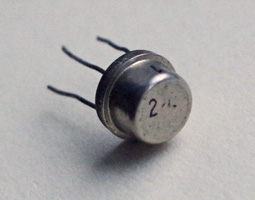
This image shows an OC2. There is obviously a suffix, but it is hard to decipher. VdH seem to have not printed the OC prefix on these later types, probably because of space limitations.
Then there are several groups of AF driver transistors:
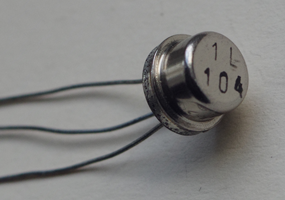
This image shows an OC1L104 in a TO-9.outline.
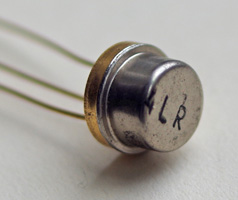
Then there are two groups of AF amplifier or driver transistors:
Here is an OC4LR.
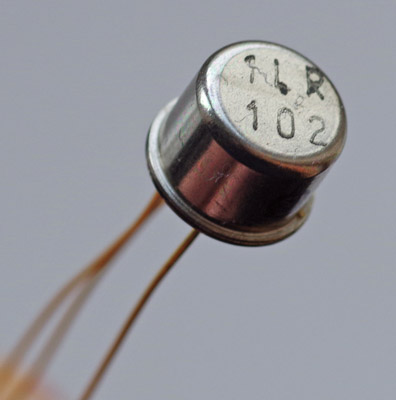
The image shows an OC1LR102 in a TO-5 outline.
Finally there is a single group of AF output transistors:
- OC2LP to OC5LP are PNP germanium with Vcbo = 30 volts
Oddly there is also listed an OC222 for 'experimental purposes'. I would be very interested to obtain examples of this type.
Note that these low numbers do NOT mean that these were the earliest OC-series devices; far from it, as evidenced by the standard encapsulation. Interestingly, members of this family were apparently competitors of the OC13 and OC14 shown above, both sets being priced relatively modestly.
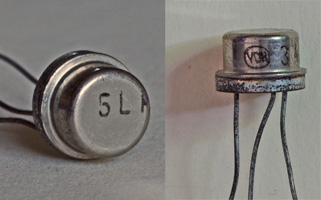
Here is a composite image of an OC5, again with the suffix LR, or possibly LP. There is a 3-digit number printed around the side, but this is not the part number suffix: it may be a date code.
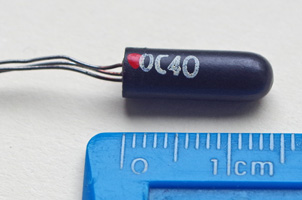
And here is an oddity: I believe that it is an OC4O (that's a suffix O, not OC-forty, the latter does not exist as a germanium transistor). The vendor told me that it was supplied by Van der Heem, but it bears no indication of that, just a Philips-type code Z2 k9. The VdH transistor list only shows a simple sketch of the TO-9 outline and makes no mention of alternatives.
I am seeking examples of other VdH OC types for my collection, so if you have some for sale or exchange, please

I bought a very dilapidated Erres transistor radio type RA662 1AT because its entire transistor line up consists of Japanese transistors rebranded by Van der Heem. Hans Hilberink states that this was done across the 'famous 2SA12 to 2SB77 series', mainly manufactured by Hitachi. My image shows one from my radio, a 2SA12. All the transistors in the radio use the same TO-1 outline, although they are of several types, and all are marked 'vdHEEM'. I'm sure that these are rebranded and not VdH manufacture.